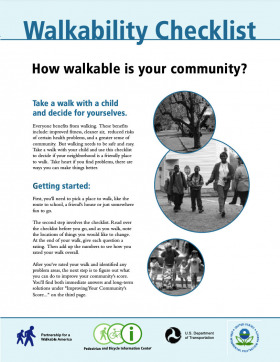- September 29th, 2023
- 0 Comments

October is Pedestrian Safety Month, so... How walkable is your community? Find out by using this checklist from Partnership for a Walkable America, Pedestrian and Bicycle Information Center, U.S. Department of Transportation, and U.S. Environmental Protection Agency by taking a walk with your child, a friend, or neighbor to decide for yourself whether your neighborhood is a friendly place to walk.
First, you'll need to pick a place to walk, like the route to school, a friend's house or just somewhere fun to go. The second step involves the checklist, so read over it before you go and, as you walk, note the locations of things you would like to change. At the end of your walk, give each question a rating. Then add up the numbers to see how you rated your walk overall. After you've rated your walk and identified any problem areas, the next step is to figure out what you can do to improve your community's score. You'll find both immediate answers and long-term solutions under "ImprovingYour Community's Score..." on the third page.
Questions will focus on whether you've got room to walk, whether it's easy to cross streets, whether drivers behaved well, if it was easy to follow safety rules, and if the walk was generaly pleasant. Your answers will stack up to provide a final rating which can be plotted in ranges from "A great neighhborhood for walking" to "a disaster for walking." And once you've identified potential problems, the checklist then offers some guidance on how you can help to improve your community's walkability score.
For example, did you have room to walk? Did sidewalks or paths start and stop, were they broken or cracked, were they blocked, or were there no sidewalks, paths, or shoulders at all? Was there too much traffic to feel safe while walking? If so, you can help immediately by: Picking another route for now, and then telling local traffic engineering or public works departments, or city council officials, about the specific problems you encountered, and sharing a copy of your checklist. With more time, you and your community can speak up at community meetings, write or petition the city for safer walkways and gather neighborhood signatures, contact local news media to make them aware of the problems, and advocate to connect with local transportation engineers to develop a plan for a safer walking route in your community.
Was it easy to cross streets on your route? Was the road too wide, or did traffic signals make you wait too long to cross, or not provide enough time for you to safely cross with the right-of-way? Are crosswalks or traffic signals needed? Was the view of traffic blocked by parked cars, trees, plants, or other obstructions? Are curb ramps needed or in need of repair?
Did drivers behave well on your route? Did any drivers back out into the walking path without looking, or fail to yield to pedestrians with the right-of-way? Did drivers turn into walkers as they crossed the street, speed up to make traffic lights when yellow, or drive through red lights?
Could you follow safety rules? Were you able to cross at crosswalks or where you could clearyl see traffic and be seen by traffic? Could you safely stop and look left, right, and left again before crossing? Could you walk on sidewalks or shoulders facing oncoming traffic, and could you cross with the traffic signals when pedestrians were given the right-of-way?
Was your walk pleasant? Could improvements to grass, flowers, or trees improve your route? Were there scary dogs or people along the route? Was it well lit? Was there excessive litter or other debris along the route? Was there significant amounts of traffic?
Check out the complete Walkability Checklist for links to more great resources like walking information from Pedestrian and Bicycle Information Center (PBIC) and Natinoal Center for Bicycling and Walking Campaign to Make America Walkable; Walk to School Day websites; Street Design and Traffic Calming resources from Federal Highway Administration Pedestrian and Bicycle Safety Research Program, Institute of Transportation Engineers, Surface Transportation Policy Project, and Transportation for Livable Communities; Walking Coalitions like America Walks and Partnership for a Walkable America National Safety Council; Pedestrian Safety resources from National Highway Traffic Safety Administration Traffic Safety Program and National SAFE KIDS Campaign; Accesible Sidewalks information from US Access Board; and other Walking and Health resources from US Environmental Protection Agency Office of Children's Health Protection, President's Task Force on Environmental Health Risks and Safety Risks to Children, Centers for Disease Control and Prevention Division of Nutrition and Physical Activity, Prevention Magazine, and Shape Up America.













